Library Management System UML Diagrams
Library Management System UML Diagrams are based on the Unified Modeling Language. These diagrams are used to represent the library management system as well as its primary users, roles, activities, artifacts, or classes. The UML Diagrams are created to easily understand, update, maintain, and document library management system information.
UML diagrams for library management system were used to visualize the project. It can be done before the development begins or to document its progress once it is completed. However, Library Management System UML Diagrams can be used in any sector, not only in software engineering. Its overall objective is to help teams or developers visualize what a project is or how it will work.
Library Management System UML Diagrams: Table of contents
Library Management System UML Diagrams: Project Details
The table shows the name and details of the library management system UML diagrams. It has complete information on project components and diagraming tools.
| Name: | Library Management System UML Diagrams |
| Abstract: | Library Management System UML Diagrams are used to represent the library management system as well as its primary users, roles, activities, artifacts, or classes. |
| Users: | School Admin, Book Borrowers, and Librarian. |
| Tools Used: | Diagram tools that provide UML diagram symbols. |
| Designer: | ITSourceCode.com |
Users of Library Management System
The users of the College Library Management System Sequence Diagram are the following:
- School Librarian: The school librarians will be the ones to use the system most of the time. They will monitor the books from time to time and will cater to the borrowing and returning of books. They were also responsible for all the activities related to the library.
- Book Borrowers: Book borrowers were not just the students but also the professors or instructors. They will also have access to the system and to do that, they will have to log into the system. This will help the librarian and the admin monitor the book borrowers.
- School Admin: The Library Management System can be a stand-alone project or a part of a bigger project. Nevertheless, it always has the admin which can access all of the library information. This is done when there are serious scenarios or problems.
List of UML Diagrams for Library Management System:
- Sequence Diagram
- Activity Diagram
- Class Diagram
- Use Case Diagram
- Deployment Diagram
- Component Diagram
The UML Diagrams of Library Management System
Here are the UML Diagrams that complete Library Management System. Each of the UML Diagrams has a major role in achieving a well-developed and functioning Library Management System.
Sequence Diagram for Library Management System
The Sequence Diagram for Library Management System represents the scenario and the messages that must be passed between objects. This is done for the scenario’s functionality to be realized. It’s an interaction diagram that shows how activities are carried out, including when and how messages are sent.
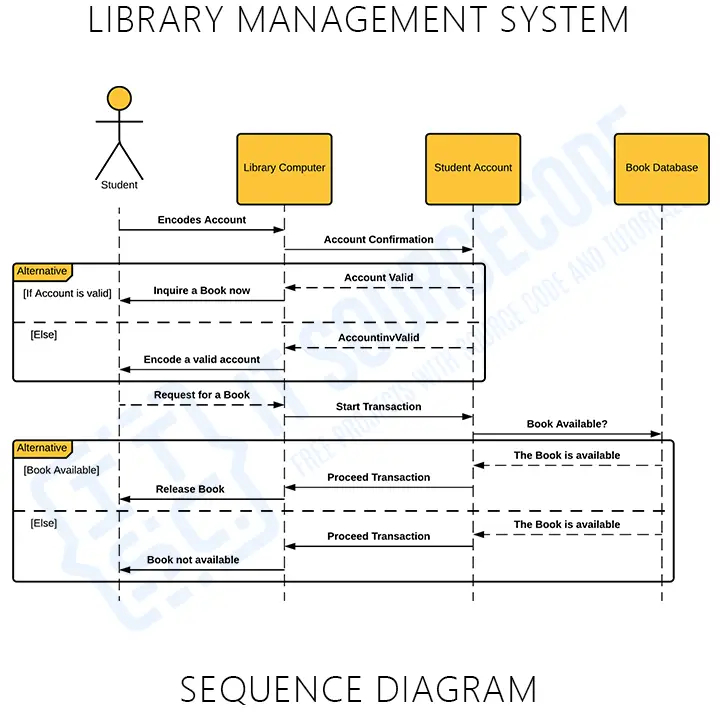
The sequence diagram given shows 4 objects which are: the student, library server (computer), account database, and book database. These objects were based on practical activities that happen in library management. The sequence of messages was plotted below the objects to determine how the process is being performed.
Activity diagram for Library Management System
The Library Management System Activity Diagram is one of the UML behavioral diagrams. It shows the system’s behavior by presenting the flow of activities from one to another. The possible flow of activities can be in order, split, or continuous.
Activity Diagram for Library Management System (Librarian) – This illustration shows the activities and scenarios done when the librarian access the system. The actions and decisions included were all emphasized here.
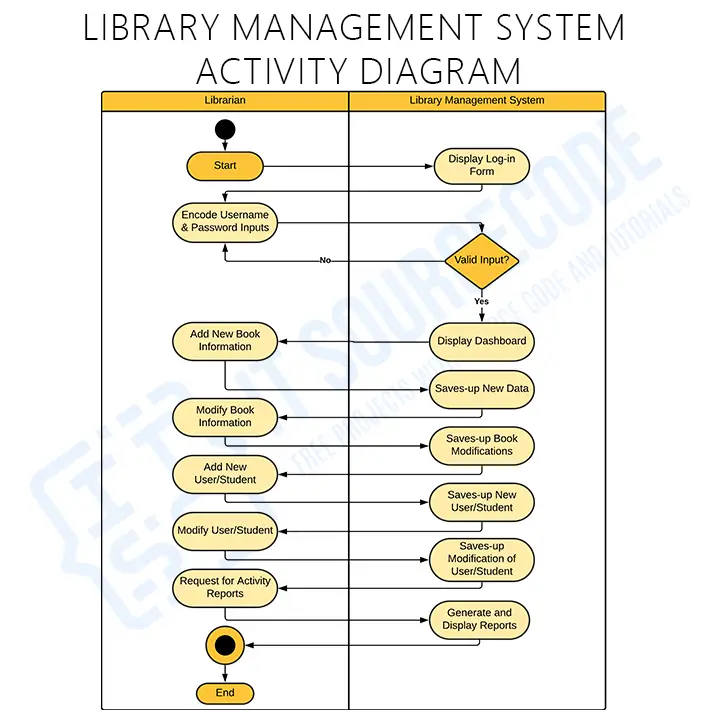
Library Management System Activity Diagram (for Students). This diagram now shows the series of scenarios while using the library management system. It illustrates the activities or events done when the system is in use. The system design can show you the functions for the student side.
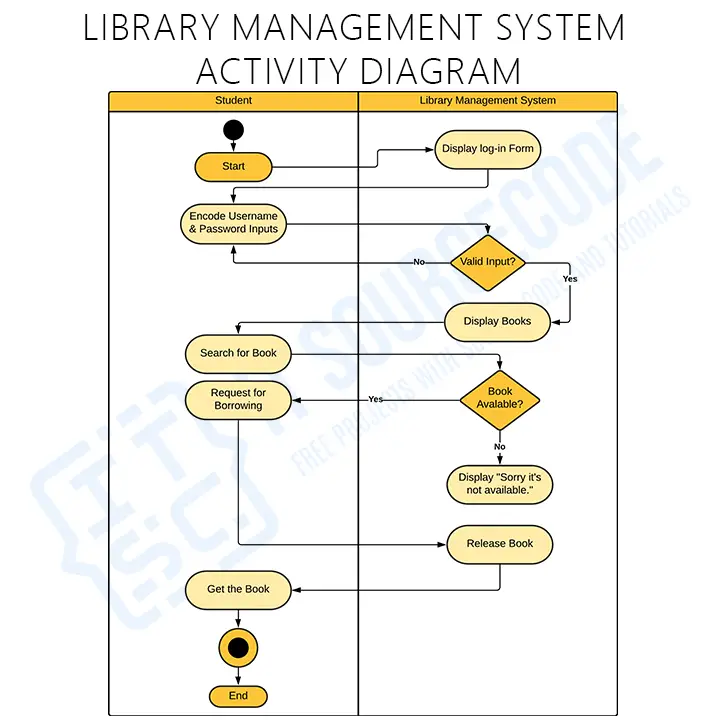
Class Diagram for Library Management System
A Library Management System Class Diagram is a form of structural (UML) diagram that depicts the structure of a system. This is designed by displaying the system’s classes, attributes, methods, and relationships between classes.
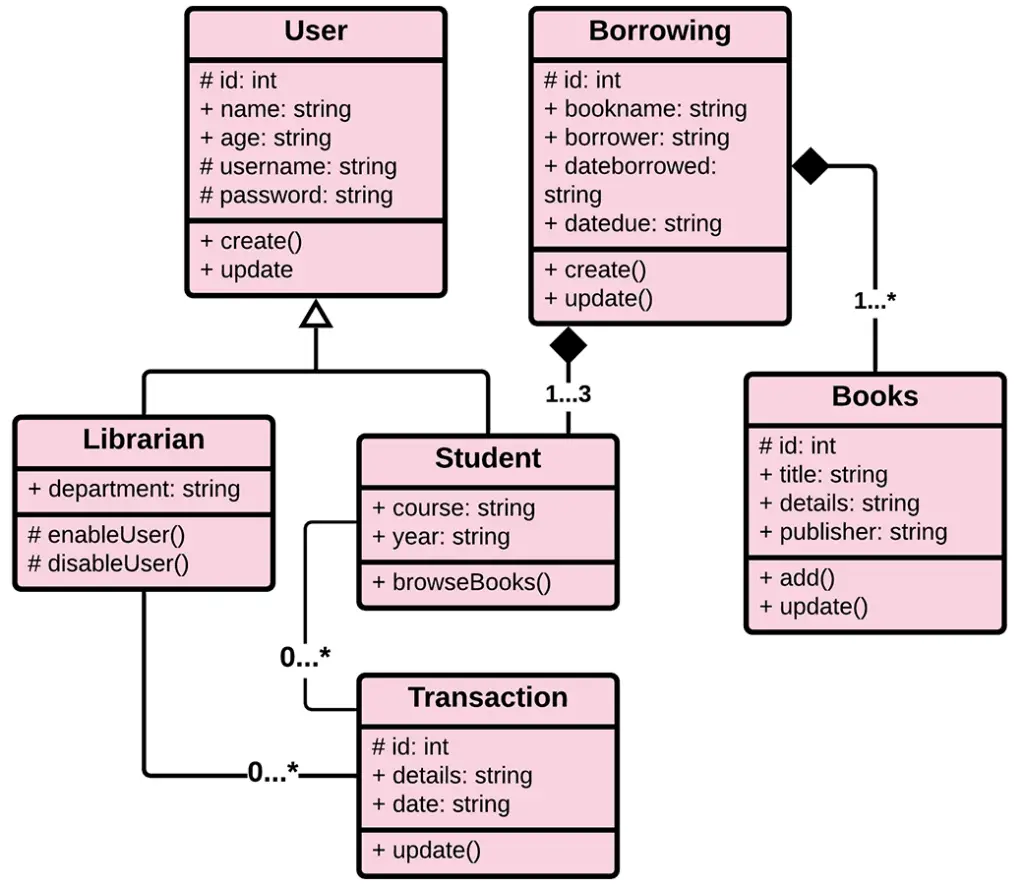
Class diagrams reveal the class structure blueprint of the Library Management System. It is used to model the items that make up the system and depict their relationships. This is to define the function of an object and the operation it provides.
Use Case Diagram for Library Management System
The Library Management System Use Case Diagram is a graphic summary of the software and user details. It’s usually depicted as a graphical representation of the entities’ interactions.
The General Use Case Diagram of Library Management System contains the main use cases and users in the system. These use cases will be elaborated on in the following diagrams.
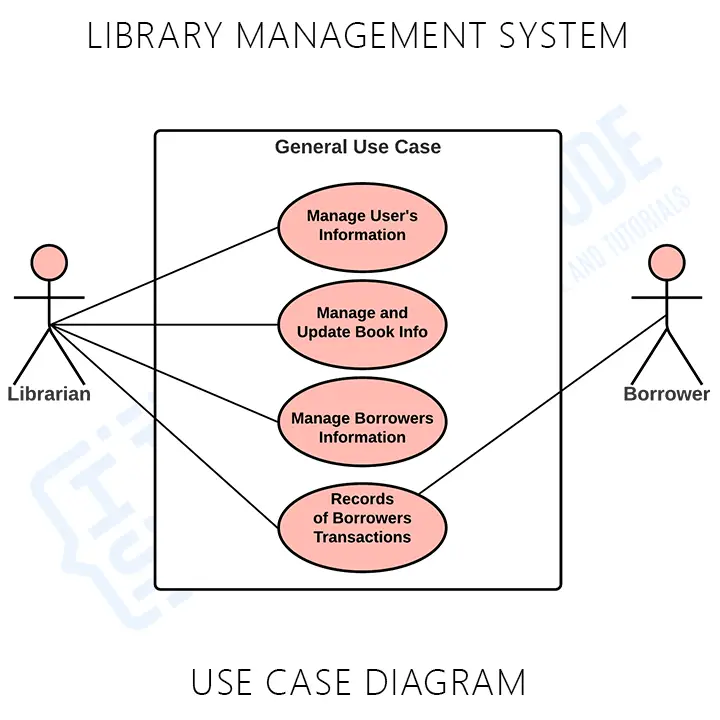
The diagram shows the main use cases in Library management. The use cases are the User’s information management, Book information management and updates, borrowers management, and management of transaction records.
Use Case Diagram for Library Management System using Include and Extend (Manage User’s Information)
This diagram focuses mainly on the use case “Manage User’s Information”. It includes the sub-processes which are pre-requisite to complete user information management.
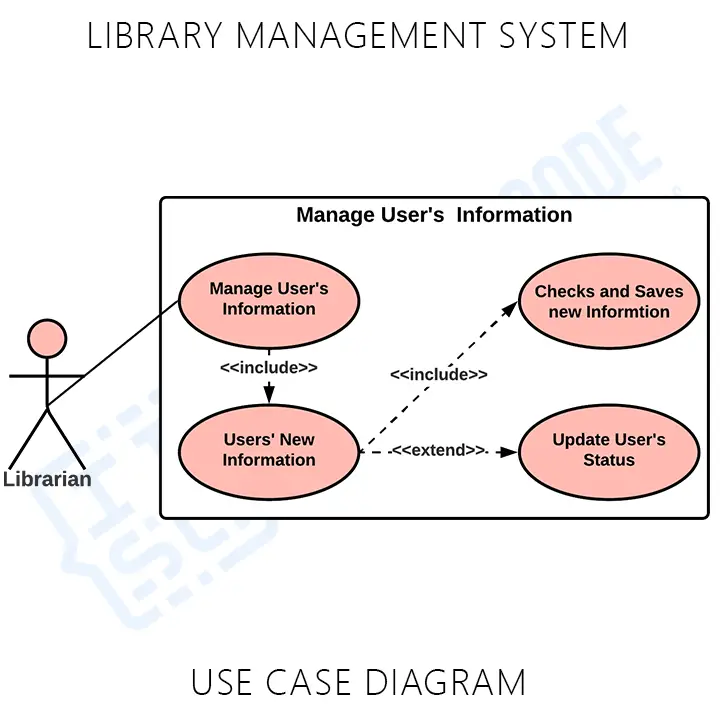
The presented use case diagram explains the included processes when managing users’ information. The processes with <<include>> indicators were the “Users New Information” and “Checks and Save the New Information”. That means they must be included in the main process and the other process “Update Users Status” is only done when needed.
Use Case Diagram for Library Management System using Include and Extend (Manage and Update Book Info)
This diagram focuses on the use case “Manage and Update Book Information”. It includes the sub-processes which are pre-requisite to complete Book’s information management and update.

Another presented use case diagram explain the included processes when managing and updating book information. The processes with <<include>> indicators were the “Book’s New Information” and “Checks and Save the New Information”. That means they must be included in the main process and the other process “Update Book Status” is only done when needed
Use Case Diagram for Library Management System using Include and Extend (Manage Borrowers Information)
This diagram focuses on the use case “Manage Borrowers Information”. It includes the sub-processes which are pre-requisite to complete Borrowers’ information management and update.

Another presented use case diagram explain the included processes when managing and updating borrowers’ information. The processes with <<include>> indicators were the “Borrower’s New Information” and “Checks and Save the New Information”. That means they must be included in the main process.
You can see that the next process is labeled <<extend>> because it is a conditional process. The sub-use case “Update Borrower’s Status” is only performed when needed. Then this process invokes the must be done cases such as “Checking of Borrower’s Transaction” and “Recording of Transaction”.
Deployment Diagram for Library Management System
A deployment diagram is a form of UML model used to describe the execution architecture of the Library Management System. It contains elements such as hardware, software, and the middleware that connects them. UML Deployment Diagram presents the system’s physical hardware and software.

Component Diagram of Library Management System
The Library Management System component diagram in the (UML) Unified Modeling Language shows how parts are wired together to create bigger parts of the library system. They are used to show the structure of the library management system.
The UML component diagram shows how a library management system is made and the set of deployable components, such as dynamic-link library (DLL) files, executable files, or web services. Using well-defined interfaces, these parts communicate with each other and keep their internal details hidden from each other and the outside world.

Bonus Diagrams for Library Management System
Data Flow Diagram for Library Management System
The Library Management System DFD represents the “flow” of data in all processes present in Library Management. This DFD for Library Management System is also known as Data Flow Diagram. Its diagram has three levels that elaborate on the overall data flow.
DFD Level 0 shows the entities that interact with the system. It defines the border between the system and its environment. This context diagram depicts Library Management Project at a high level.
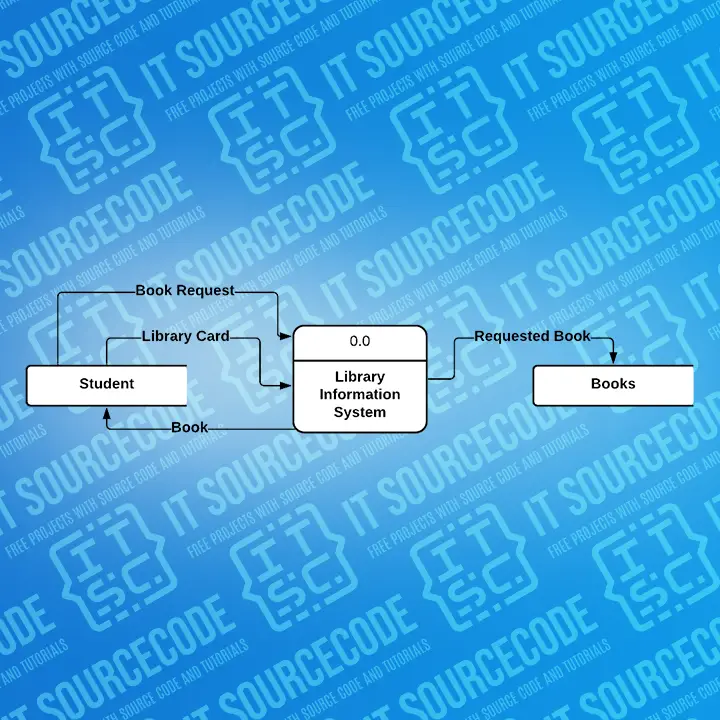
The illustration presents the main process in a single node to introduce the project context. This context is explaining how the project works in just one look. The user feeds data into the system and then receives the output from it.
The DFD Level 1 shows the wider details of Library DFD Level 0. This is to clarify the paths (flow) of data and its transformation from input to output. The designed diagram portrays two different scenarios which are the Book Delivery and the topic search.
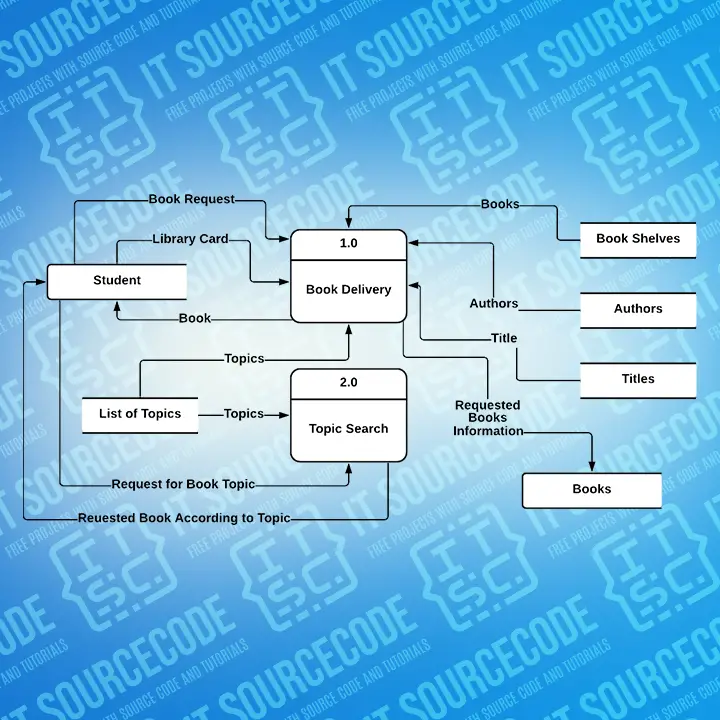
The flow of data starts from the student giving the borrowing request and his/her information. The system then caters to the information and processes the request. By that, the process generates the data flow and transformation until it reaches the desired output.
Level 2 DFD for Library Management System is also called the highest abstraction of a data flow diagram. This level also broadens the idea from the DFD level 1. It includes the sub-processes from level 1 as well as the data that flows.
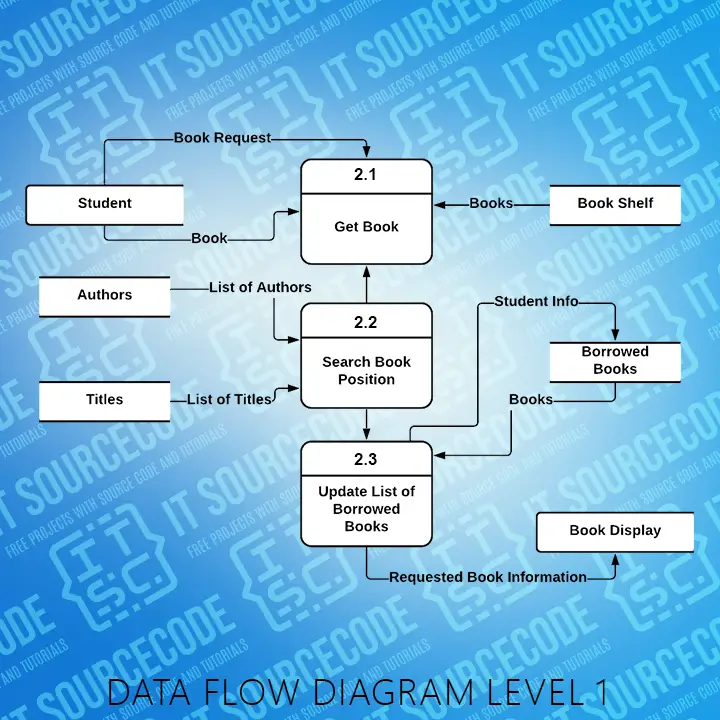
This diagram has elaborated the sub-processes derived from the “topic search” process. The sub-processes were: get a book, search book position, and update. These processes were invoked by the book borrower and then catered to by the system.
ER Diagram for Library Management System
The College Library Management System ER Diagram reveals the relationships between college library entity sets in a database. This displays the logical structure of databases. It is done by identifying entities, their properties, and the interactions between them.
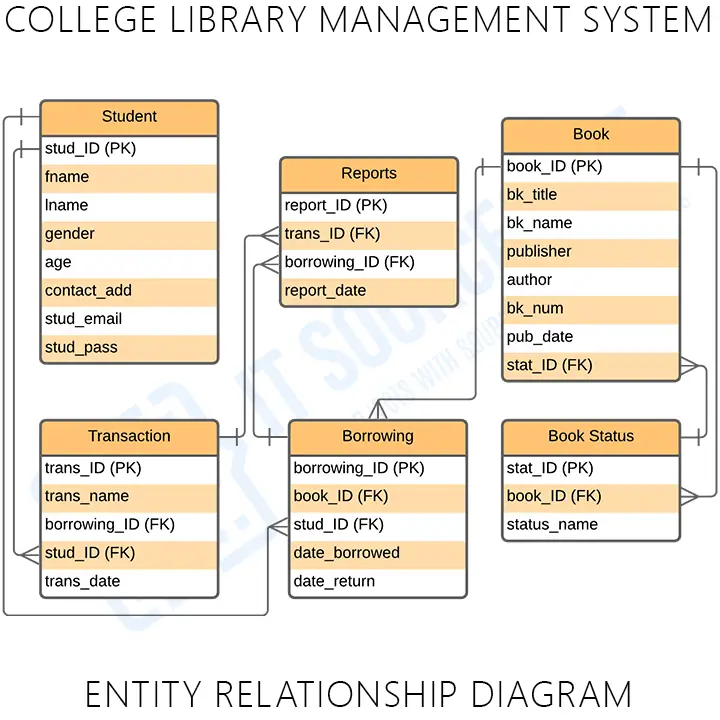
This diagram presents the Entities’ Relationship Model for College Library Management System. It is used to enlighten you on how the back end of the database of the project works. The tables are made to meet the required specification of the system and provide much more specific details of each entity within the system.
UML Diagrams for Library Management System (PDF)
The UML diagrams for Library Management System PDF are compiled and provided here and can be accessed for free. It has the complete discussion of the UML Diagrams and you can easily download these by clicking the button below.
This PDF File for Library Management System UML Diagrams can be modified if needed. Its diagrams were based on software engineering ideas. This means that the UML diagrams could also be applied to your Capstone Project.
UML Diagrams for Library Management system DOC
The UML diagrams for Library Management System DOC are compiled and provided here and can be accessed for free. The complete discussion of the UML Diagrams has been documented so you can easily download these by clicking the button below.
This Document File (doc) for Library Management System UML Diagrams can be modified if needed. Its diagrams were based on software engineering ideas. This means that the UML diagrams could also be applied to your Capstone Project.
How does a library management system work?
A library management system is utilized to keep track of library records. It keeps track of the number of books in the library, how many are issued, how many are returned or renewed, and other matters that concern library management.
The library management system enables librarians and library users to do their tasks more efficiently. It also gives convenience for librarians to arrange books and keep track of those that have been given, reissued, and not retrieved.
The librarian uses the Library Management System to manage all types of library activities and events. Libraries benefit from scalable architecture, secure access, performance, and reliability. This helps in enabling smooth access to the database.
Importance of UML Diagrams for Library Management System
The importance of Library Management System UML Diagram is that it offers standard notation that any object-oriented method can use. This is also used to choose and combine the best aspects of preceding notations.
The basic goal of Library Management System UML Diagram is to provide a general-purpose, easy-to-understand modeling language that is applicable to all. UML is not a development approach, but it is used in conjunction with other methods to create a successful library management system.
What are UML Diagrams for Library Management System?
The UML Diagrams for Library Management System are based on Unified Modeling Language which is the standard language for describing, visualizing, building, and documenting software system artifacts. These are also used in business modeling and non-software systems. It has been discovered that all UML diagrams serve an important role in Library Management System development.
The Unified Modeling Language (UML) is a platform-independent and progressive modeling language used in the software engineering field to depict a system’s architecture. UML Diagrams are the visual representation of the project’s architecture, development, and implementation.
Bonus Tips on Designing the UML Diagrams of Library Management Project System
To design your UML diagrams, you may use platforms and editing tools online. These tools are helpful since they already have the needed symbols to illustrate your diagrams. You just have to plot the included symbols, arrows, and labels. The platforms or online tools that you may use are:
• Lucidchart
• Creately
• Smartdraw
• Edrawmax
• Canva
Conclusion:
All in all, the Library Management System UML Diagrams work together to achieve their most desired functions. All of these were designed to guide programmers and beginners of what should be the behavior and structure of the Library Management System.
By completing all the UML Diagrams, project development would be much easier and attainable. These UML diagrams were given to teach you and guide you through your project development journey. You can use all f the given UML diagrams as your reference or have them for your project development. The ideas presented in UML Diagrams were all based on Library Management requirements.
Related Articles:
- Online Shopping Complete UML Diagrams
- Hospital Management System Project UML Diagrams
- Online Railway Reservation System UML Diagrams
- Online Airline Reservation System UML Diagrams
- Hotel Management System UML Diagrams
Recommended Articles from the Author:
- Library Management System Project in Ruby on Rails with Source Code
- Library Management System In ASP NET With Source Code
- Library Management System Project in Laravel With Source Code
- Online Library Management System in PHP Source Code
Inquiries:
Now let me ask you something. What have you learned through the discussion? May this article help you with your projects in the future! If you have inquiries or suggestions about the Library Management System UML Diagrams just leave us your comments below.
Keep us updated and Good day!


Your blog seemed good to me… until I discovered that the arrows on your use case diagrams are misdirected… disappointment … :'(
We were sorry for that its our mistake because were not perfect.
Hi, is there a source code for this project? Can I get it?